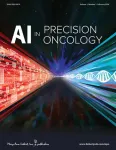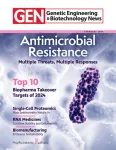(Press-News.org) ALBUQUERQUE, N.M. — One of Sandia National Laboratories’ core missions is to help the world through innovation.
However, transferring some of that innovation from the Labs to industry isn’t always an easy process.
Through hard work and ingenuity, some Sandia employees are excelling at moving technology to market, a feat that is now being honored by the Federal Laboratory Consortium. The consortium, composed of more than 300 members nationwide, provides a forum to develop strategies and opportunities for linking laboratory technologies and expertise in the marketplace.
Regional Technology Transfer Award: Disinfectant 2.0
The winner of the 2024 Federal Laboratory Consortium Technology Transfer Award for the mid-continent is Disinfectant 2.0. It’s a product that kills viruses, bacteria and fungi for long periods and was developed in the middle of the COVID-19 pandemic using technology developed at Sandia.
It’s the creation of materials scientist Hongyou Fan and his team, along with the company Lunano, LLC, based in McLean, Virginia.
Fan started working with Lunano in January 2020 as part of the FedTech Startup Studio program to explore how to use nanomaterial technology developed at Sandia for disinfectant applications. When the pandemic hit, that partnership kicked into high gear.
Lunano CEO and co-founder Bradley Duckworth said he remembers a conversation he had with a Lyft driver:
“We talked about the challenges the company was facing trying to keep their drivers’ cars disinfected for customers,” Duckworth said. “I asked him, ‘well, if you were able to have a product that didn’t give your customers headaches and wasn’t unpleasant to smell and it worked continuously, would this be something that would be interesting for you?’ He said, ‘Absolutely.’”
That was all the convincing the team needed to get to work quickly. They reached out to more industries, including hotels, restaurants and airlines and realized the great need for such a product and how it could help everyday life.
From that point, Duckworth, Fan and their teams decided to pursue a process called detergent-assisted fabrication of porphyrin nanoparticle photosensitizers.
How it works
Porphyrins are photo pigments that, when exposed to light, go through a chemical reaction.
The team assembled these porphyrins into nanomaterials that can be integrated into sprays, compounds and membranes, as well as in manufactured surfaces.
When they are exposed to light, the chemical reaction is triggered, releasing a highly reactive species that kills disease cells, including E. coli, Staphylococcus aureus, staph infection, viruses, bacteria and fungi. While disinfectants generally must be reapplied to high-touch surfaces regularly, Disinfectant 2.0 has a months-long to a years-long life span.
“The beauty of this is that light is the trigger,” Fan said. You have light everywhere and it’s free. Take a taxi for example; in it you have customers who bring germs. You spray Disinfectant 2.0 onto the car seat’s surface and when the light hits it, you kill the germs.”
Getting it commercialized
Creating the product is just the first step. Often, one of the hardest steps is getting it to industry. This team worked together to get the technology licensed quickly and under extraordinary circumstances.
The teams spent hours working together online because of the COVID-19 pandemic and health restrictions, all while still doing their day jobs.
“When they started, there were so many uncertainties,” said Robert Westervelt, a licensing executive with Sandia who worked on the project. “They went through trainings and did some 500 interviews. They found a good patent attorney and found angel investors.”
Lunano was then able to license the technology at no cost under a special license Sandia created during the pandemic.
Lunano is now conducting research with large companies to determine how to best integrate Disinfectant 2.0 technology into their products and how to produce it on a mass scale. They’re planning to create 100 jobs in the process.
Leaving a mark on the world
This technology is poised to have a lasting effect.
“I think it’s one of the top technologies that I’ve had the ability to help commercialize just because of the breadth of its impact,” Westervelt said.
Fan said he’s excited to see where it goes from here.
“Years ago, when I started this work at Sandia, I was focused only on the fundamental science side,” he said. “When the pandemic hit, we realized what a huge impact our work could have on the world, especially during a time of crisis. Now I feel so excited. You don’t know what a big a deal this science can be in the future.”
Fan, who was recently named a fellow of the American Chemical Society continues to tackle new challenges over a wide range of applications including nanoelectronics, energy and materials integration.
He currently manages Sandia’s Geoscience Core Program for the Department of Energy’s Office of Science Basic Energy Science. He is also the manager of the Geochemistry department, a group of scientists who are addressing national problems in CO2 reduction, hydrogen storage and critical minerals recovery to address the Bipartisan Infrastructure Law. In this work they are helping to establish secure sustained domestic critical minerals supply chains.
Outstanding Tech Transfer Professional
The Federal Laboratory Consortium has also named Sandia’s Chief Intellectual Property/Patent Counsel Samantha Updegraff as Outstanding Tech Transfer Professional of the Year for her ability to devise creative ways to successfully accomplish Sandia’s tech transfer mission.
Updegraff’s success can be credited in part to her non-traditional background. She earned a bachelor’s degree in chemical engineering and worked in the pharmaceutical industry before becoming interested in patent law through a friend and colleague. She decided to go to law school at the University of New Mexico when she moved back home to Albuquerque with her husband.
“My husband began his Sandia career, and I knew I wanted to work here in some capacity in the future,” Updegraff said. “It really is the gold-standard employer in the state. When I was hired into the licensing group, I discovered how broad Sandia’s tech portfolio is and how impactful transitioning these technologies outside the national laboratories can be to the nation.”
In her time at Sandia, Updegraff has led the way in updating licensing and tech transfer agreement templates, greatly streamlining the process.
She helped create Sandia’s new faculty loan program, which allows Sandia employees to work in both the Sandia and university environments under temporary loan arrangements and further develop technologies that have tech transfer opportunities.
Updegraff also assisted in the negotiation of a high-value license with a major electronics company for an entire portfolio of patents and worked closely with Los Alamos National Laboratory to get the TRGR Technology Readiness Initiative off the ground.
Among her biggest accomplishments is spearheading the creation and implementation of a copyright transfer program that makes it easier for Sandia staff to publish their advancements and technologies for the public good. Samantha said she’s delighted to be recognized but still has work to do.
“I hope to streamline or at least demystify partnership processes at Sandia, making it easier for industry, government, academia and other national laboratories to work with us,” she said. “The hope is to lower the barrier to entry and ensure more technologies can be transferred to external partners, especially those who haven’t partnered with Sandia or national laboratories before.”
State and Local Economic Development Award – TRGR Technology Readiness Initiative
The FLC is also recognizing the TRGR Technology Readiness Initiative and its success in moving technology developed at the national labs to market.
They’ve awarded it the 2024 State and Local Economic Development Award.
The program, created in 2020, allows New Mexico businesses that have licensed technology from Sandia and Los Alamos National Laboratory, or engaged in a Cooperative Research and Development Agreement, to receive up to $150,000 in technology maturation assistance from the labs to help ready products and services for the marketplace.
Almost $1.5 million in lab hours have been used over the last three years to benefit New Mexico businesses. As a result, 15 licenses and three new Cooperative Research and Development Agreements have been secured.
Among the success stories is that of Kairos Power, a nuclear energy engineering, design and manufacturing company. The company is commercializing a fluoride salt-cooled high-temperature reactor with a mission of enabling the world’s transition to clean energy.
Through TRGR, Kairos Power was able to access Sandia’s specialized equipment and expertise to develop a necessary sensor. They are now using engineering expertise at Los Alamos to further the design of a new facility.
The company’s testing and manufacturing facility in Albuquerque will support the design, construction and operation of the Hermes demonstration reactor in Oak Ridge, Tennessee.
The New Mexico Legislature has extended the tax credits necessary for the program through 2027.
Sandia National Laboratories is a multimission laboratory operated by National Technology and Engineering Solutions of Sandia LLC, a wholly owned subsidiary of Honeywell International Inc., for the U.S. Department of Energy’s National Nuclear Security Administration. Sandia Labs has major research and development responsibilities in nuclear deterrence, global security, defense, energy technologies and economic competitiveness, with main facilities in Albuquerque, New Mexico, and Livermore, California.
Sandia news media contact: Kim Vallez Quintana, kdquint@sandia.gov, 505-537-3294
END
Sandia awarded for outstanding work in technology transfer
Includes commercialization of long-lasting COVID-killing disinfectant
2024-02-09
ELSE PRESS RELEASES FROM THIS DATE:
Evaluating AI-based nodal contouring in head and neck cancer
2024-02-09
A new study evaluates an artificial intelligence (AI)-based algorithm for autocontouring prior to radiotherapy in head and neck cancer. Manual contouring to pinpoint the area of treatment requires significant time, and an AI algorithm to enable autocontouring has been introduced. The study is published in the peer-reviewed journal AI in Precision Oncology. Click here to read the article now.
Sushil Beriwal, from Allegheny Health Network, and Varian, and coauthors, analyzed 108 patients ...
The Lancet: Black women in the USA were murdered six times more often than White women between 1999 and 2020, state-level analysis indicates
2024-02-09
Analysis of racial disparities in US homicide rates indicates Black women were on average six times more likely to die by homicide than White women between 1999 and 2020.
Homicide rates among Black women were significantly higher than for White women in all 30 states analysed, with some evidence suggesting the biggest differences are in states with the highest racial inequities.
The greatest disparity in homicide rates was in Wisconsin in 2019-2020, when Black women were 20 times more likely to be ...
Study shows clinical benefit of new way of treating advanced ER+ breast cancer
2024-02-09
A research paper published today (8 February 2024) in The Lancet Oncology demonstrates that the drug enobosarm, a selective androgen receptor modulator which stimulates the male sex hormone receptor has anti-tumour effects in oestrogen receptor positive breast cancer patients.
Lead author Professor Carlo Palmieri from the University of Liverpool and The Clatterbridge Cancer Centre NHS Foundation Trust, said: “These results are very encouraging – we have shown that in advanced/metastatic breast cancer ...
Repeat testing for pre-eclampsia does not lead to better outcomes for pregnant women, but a single test is still beneficial
2024-02-09
A single test to speed up diagnosis of a serious disease in pregnant women does not need to be repeated, new research has found.
Results from the PARROT-2 trial, published today in the Lancet by researchers from King’s College London and funded by Jon Moulton Charitable Trust, Tommy’s Charity and the National Institute for Health and Care Research, has ruled out the need for routine repeat placental growth factor-based testing (PIGF) for all women with suspected pre-eclampsia.
PARROT-2 is a large, multi-centre UK trial in 1,252 women ...
Industrial pollution leaves its mark in Mediterranean corals
2024-02-09
UCL Press Release
Under embargo until Friday 9 February, 00:01 UK time
Industrial pollution leaves its mark in Mediterranean corals
For the first time, pollutants from burning fossil fuels have been found embedded in corals, offering scientists a potential new tool to track the history of pollution, finds a new study led by UCL researchers.
The study, published in the journal Science of the Total Environment, identified carbon particles emitted by burning fossil fuels embedded in the corals of Illa Grossa Bay, off the Columbretes Islands in the Mediterranean Sea. Finding this type of pollution – known as fly-ash or spheroidal carbonaceous particles (SCPs) ...
Urgent call for antitrust measures to safeguard innovation in spatial biology
2024-02-09
Recent breakthroughs in spatial biology technology have transformed biomedical research; however, legal disputes are preventing small, innovative companies from advancing new technologies and ideas. Ongoing litigation poses a threat to the progress of even the most promising scientific technologies and the potential discoveries they could enable, according to the authors of the exclusive article titled “Sounding an Alarm Over Spatial Biology,” in Genetic Engineering and Biotechnology News (GEN). Click here to read the article ...
Pre-diabetes gets its due: New $1.2 million award aimed at early intervention and treatment
2024-02-09
SAN ANTONIO, Feb. 8, 2024 – More than one out of three people have pre-diabetes, characterized by abnormal blood sugar levels not yet in the diabetes range – and yet associated with significant increases in eye, kidney and neuropathic diseases, and risk of cardiovascular death.
Moreover, the number of people with the condition is expected to double by 2030, with prevalence substantially higher in minority populations, including Hispanics. Both pre-diabetes and diabetes are considered global epidemics.
As pre-diabetes largely is underdiagnosed and undertreated, ...
Celebrating excellence in anatomy: AAA awards distinguished members
2024-02-08
ROCKVILLE, MD – February 8, 2024 – The American Association for Anatomy (AAA) is honored to announce its 2024 awards recipients. Eighteen of the association’s 2,455 members have been selected because they advanced AAA’s values: community, respect, inclusion, integrity, and discovery.
The AAA awards program provides over $650,000 in awards, research grants, and scholarships annually. Many recipients go on to achieve significant success in their careers.
"We, as anatomy ...
Athira Pharma announces publication in Frontiers in Neuroscience highlighting therapeutic potential of ATH-1105 in amyotrophic lateral sclerosis (ALS)
2024-02-08
BOTHELL, WA, Feb. 8, 2024 — Athira Pharma, Inc. (NASDAQ: ATHA), a late clinical-stage biopharmaceutical company focused on developing small molecules to restore neuronal health and slow neurodegeneration, today announced publication of research highlighting the neuroprotective and anti-inflammatory effects of ATH-1105 in preclinical models of amyotrophic lateral sclerosis (ALS). The original research article, “ATH-1105, a small-molecule positive modulator of the neurotrophic HGF system, is neuroprotective, preserves neuromotor function, and extends survival in preclinical models of ALS,” authored by Berthiaume, A., and Reda, S., et al., was published ...
Sex hormones help gonorrhea fight off antimicrobials and antibiotics
2024-02-08
DURHAM, N.C. – You know that package warning that oral birth control won’t prevent STIs? Well in the case of gonorrhea, the sexually transmitted bacterium that causes the disease can use those hormones to help it resist antibiotic attacks.
Like many bacteria, this bug, Neisseria gonorrhoeae, is equipped with pumps to push the killing chemicals out of its cells. But what’s unique, according to a Duke and Emory study online this week in Nature Communications, is that the hormones of the human urogenital tract actually allow gonorrhea to make and use more of these pumps to fight intrinsic ...
LAST 30 PRESS RELEASES:
Low daily alcohol intake linked to 50% heightened mouth cancer risk in India
American Meteorological Society announces Rick Spinrad as 2026 President-Elect
Biomass-based carbon capture spotlighted in newly released global climate webinar recording
Illuminating invisible nano pollutants: advanced bioimaging tracks the full journey of emerging nanoscale contaminants in living systems
How does age affect recovery from spinal cord injury?
Novel AI tool offers prognosis for patients with head and neck cancer
Fathers’ microplastic exposure tied to their children’s metabolic problems
Research validates laboratory model for studying high-grade serous ovarian cancer
SIR 2026 delivers transformative breakthroughs in minimally invasive medicine to improve patient care
Stem Cell Reports most downloaded papers of 2025 highlight the breadth and impact of stem cell research
Oxford-led study estimates NHS spends around 3% of its primary and secondary care budget on the health impacts of heat and cold in England
A researcher’s long quest leads to a smart composite breakthrough
Urban wild bees act as “microbial sensors” of city health.
New study finds where you live affects recovery after a hip fracture
Forecasting the impact of fully automated vehicle adoption on US road traffic injuries
Alcohol-related hospitalizations from 2016 to 2022
Semaglutide and hospitalizations in patients with obesity and established cardiovascular disease
Researchers ‘listen in’ to embryo-mother interactions during implantation using a culture system replicating the womb lining
How changing your diet could help save the world
How to make AI truly scalable and reliable for real-time traffic assignment?
Beyond fragmented markets: A new framework for efficient and stable ride-pooling
Can shape priors make road perception more reliable for autonomous driving?
AI tracks nearly 100 years of aging research, revealing key trends and gaps
Innovative techniques enable Italy’s first imaging of individual trapped atoms
KIER successfully develops Korea-made “calibration thermoelectric module” for measuring thermoelectric device performance
Diversifying US Midwest farming for stability and resilience
Emphasizing immigrants’ deservingness shifts attitudes
Japanese eels, climate change, and river temperature
Pusan National University researchers discover faster, smarter heat treatment for lightweight magnesium metals
China’s 2024 Gastroenterology Report: marked progress in endoscopy quality and disease management
[Press-News.org] Sandia awarded for outstanding work in technology transferIncludes commercialization of long-lasting COVID-killing disinfectant






